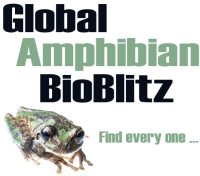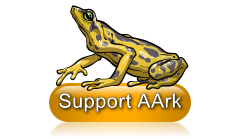The Amphibian Ark has been helping zoos, aquariums and other ex situ (captive) facilities to address the captive components of the Amphibian Conservation Action Plan, to save as many species as possible. For the past few years we have monitored and documented the great progress of ex situ amphibian rescue programs around the world. The progress of these programs includes a series of key steps in the progression of successful amphibian conservation programs. The programs that we monitor include those assessed during an Amphibian Conservation Needs Assessment as needing urgent ex situ rescue or research, and similar programs in countries where an AArk conservation needs assessment has not yet been carried out. The results of all conservation need assessments can be viewed on the Conservation Needs Assessments web site.
The programs in this list show a significant achievement by the ex situ amphibian conservation community towards reducing declining amphibian populations. By documenting this progress we are showing that zoos, aquariums and other ex situ facilities are making a vital conservation contribution towards reducing the loss of amphibian species, and for our community to be broadly acknowledged as a credible conservation partner. We have recently started to include species assessed as requiring ex situ research for conservation purposes, such as analog species from which we can develop husbandry protocols for more threatened related species. Where possible, all amphibian programs that will ultimately result in reintroduction or translocation programs should be operated within the native range of the species. Maintaining these populations within the range country generally results in lower disease risks than programs that are located outside the native range of the species. This helps to reduce the risks of introducing non‐native pathogens into the environment around the facility holding the amphibians, and the possibility of introducing novel local pathogens to amphibians that are collected and housed outside of the range country. Amphibian conservation programs that meet AArk’s definition of a “model program”, i.e. the program is based within the range country; and the population being managed is housed in isolation from other populations occurring outside its range, can be viewed on our Model Programs web page. An online database includes all programs that are currently being monitored by the Amphibian Ark. Definitions for the table headings and categories are provided below. Click the species names to view full details for each program. Some of the columns can be filtered or sorted by clicking on the column headings.
Definitions
Link – Click these species name to view the complete information for each model program. Category – the type of conservation program
- Rescue (CNAW) – Designated as requiring rescue during a Conservation Needs Assessment Workshop. A species that is in imminent danger of extinction (locally or globally) and requires ex situ management, as part of an integrated program, to ensure its survival.
- Rescue (Other) – Not designated as rescue during an assessment, but managed by national/local experts as such because no assessment has been completed.
- Supplementation (CNAW) – Designated as requiring a supplementation program during a Conservation Needs Assessment Workshop. A species for which ex situ management benefits the wild population through breeding for release as part of the recommended conservation action.
- Supplementation (Other) – Not designated as supplementation during a Conservation Needs Assessment Workshop, but managed by national/local experts as such because either (1) no assessment has been completed or (2) national/local experts wish to manage the species as a supplementation for other reasons, e.g. this is not uncommon where a species is not threatened globally but populations are struggling at the edges of the range. It is not a global priority assessment, but it is a very valid effort to keep common species common, particularly at the extremes of their distribution.
- Ex situ research (CNAW) – Either recommended for some form of ex situ research (e.g. natural history, biochemical or genetic studies) at a Conservation Needs Assessment Workshop, or being used as an analog for a species recommended for rescue during an assessment.
Start – the year the conservation program began.
Phylogeny – a complete phylogenetic analysis of the species in the wild has been carried out, to understand the functional unit being conserved (i.e. species limits have been determined). Range – most or all of the ex situ population is maintained in the range country.
Isolated – the ex situ population in housed in isolation from other populations occurring outside its range.
Offspring – the population has produced viable offspring.
F2 – first generation captive-bred animals have reproduced successfully.
Releases – captive-bred or captive-reared animals have been released to the wild.













